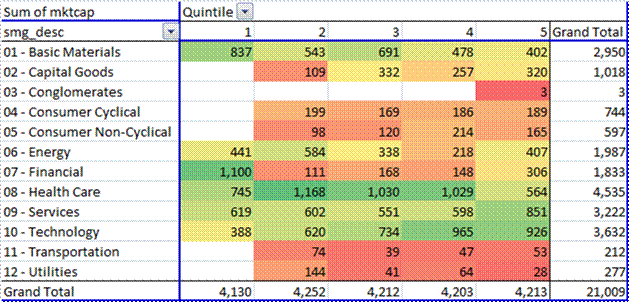I am often a fan of neglected small cap stocks.? When I find a good one, I add it to my portfolio.? But I am generally not a fan of stocks that trade below $1.00.? Why?? Because there are many promoters of the stocks who deceive those who are illiterate regarding the markets, promising big gains, but end up delivering significant losses.
I see lots of penny stock ads.? Big deal. But one ad got under my skin.? This article was motivated by an ad that said, “Penny stocks made me rich.”? Now, there may be a handful of people for which that is true, but in general, those that invest in penny stocks lose money.
There is a constant in investing, that amateurs who invest in volatile asset classes tend to lose money, and more money as the asset classes get more volatile.? Penny stocks are volatile in the extreme.? Even leaving aside the promoters who pump-and-dump, it is a rare person who can approach these in a businesslike manner.
But now, if I can, I’d like to describe the penny stock universe to you.? Here is how penny stocks differ versus the market as a whole:
 Because biotech companies tend to be small, and have a high failure rate, the healthcare sector is much larger for penny stocks.? With basic materials, the adage that a gold mine is a hole with a liar at its mouth holds true.? Thus there are more companies in those two sectors.
Because biotech companies tend to be small, and have a high failure rate, the healthcare sector is much larger for penny stocks.? With basic materials, the adage that a gold mine is a hole with a liar at its mouth holds true.? Thus there are more companies in those two sectors.
Services, Energy, Consumer Noncyclicals, and Utilities are all industries where there are increasing returns to scale, and where minimizing costs likely dominate over trying to offer specialized products that add value.
Now let’s look at penny stocks segmented by sector and size.? Same sectors, but the $21 billion of market capitalization that the 2,800+ penny stocks live in are divided into five roughly equal quintiles by market capitalization.
Here’s the breakdown:
 The financials have Fannie, Freddie, and some other large failed banks in the first quintile.
The financials have Fannie, Freddie, and some other large failed banks in the first quintile.
Health Care has a lot of companies, regardless of size.? Services, Basic Materials, Energy and Technology are similarly consistent.? Many small companies pursuing advantage versus much larger competitors.
The smaller sectors are random as should be expected. There is no surprise there.? After all, they don’t have advantages from economies of scale.
Here is my final table:
 In general, the smaller the market capitalization gets, the less liquid the stocks are.? This is not perfectly linear, because there are promoters pumping and dumping the stocks in the lowest quintile. (and in higher quintiles as well.)? The larger the market capitalization, the harder it is to pump-and-dump.
In general, the smaller the market capitalization gets, the less liquid the stocks are.? This is not perfectly linear, because there are promoters pumping and dumping the stocks in the lowest quintile. (and in higher quintiles as well.)? The larger the market capitalization, the harder it is to pump-and-dump.
So be wary when buying stocks with small market capitalizations.? All the more, pay attention to balance sheets, revenue recognition policies, and other accounting quality measures.? Act like an intelligent value investor, if you dare, because you are playing on dangerous ground.? There are safer places to play, go elsewhere.? Don’t let the seeming cheapness delude you.? This is an area where accounting frauds are rife, and where ordinary investors lose a lot.
DON’T BUY PENNY STOCKS.

I think the most important distinction to make is based not on price or liquidity or market cap but on market. 99% of pump and dumps are OTCBB or Pink Sheet stocks, not Nasdaq/Amex/NYSE issues. Avoiding OTCBB and Pinksheet stocks is the most important. Penny stocks with listings on major stock markets are much less likely to be scams / pump & dumps but they are likely distressed firms on the verge of bankruptcy or hope and dream biotechs.
Market cap isn’t the most important thing — take a look at the pump & dump POTG.pk — at a recent price of 0.36 and with 4.452 billion shares outstanding it has a market cap of $1.6 billion.
http://www.otcmarkets.com/edgar/GetFilingHtml?FilingID=8145908
Thanks, Michael. That’s a very good point. Market structure matters a lot.
Back in the 1980s I took a flyer on a company called DentoMed, a penny stock. I bought at $1.50 and sold at $3.50. I figured I was doing good making over 100% on my 1000 shares. You know, that stock went up to $16.50 before it crashed back to $1.00. What most investors do not know is that many brokages houses make the market for the penny stocks. My father did the same thing back in the early 60s with a cosmetic company . Turned out that a brokerage in Philidelphia was making the market, driving the prices up. He took his modest profit and got out. Yes, you can make money in penny stocks, but I figure you are lucky if you do. The problem is, you don’t know who is making the market for the particular stock. I could afford to gamble with $1500, and I made $2000, wonderful. But I could have lost money. My point is, I could afford the loss. But at 10,000 shares or more? No way. Now weare talking real money.